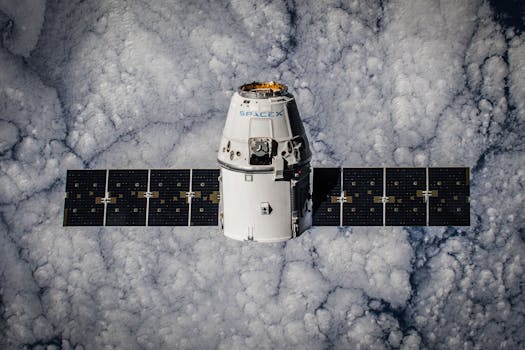The Future of Satellites: Advancements and Innovations in Space Technology

The Future of Satellites: Advancements and Innovations in Space Technology. The future of satellites is rapidly evolving with advancements in technology, new applications, and increasing demand for satellite services. Satellites have been a crucial part of modern life, providing essential services such as communication, navigation, and weather forecasting. As technology continues to advance, we can expect to see significant improvements in satellite design, launch systems, and applications.
Satellites have come a long way since the launch of the first artificial satellite, Sputnik, in 1957. Today, there are thousands of satellites in orbit around the Earth, providing a wide range of services. The future of satellites looks promising, with new technologies and innovations being developed to improve their performance, efficiency, and cost-effectiveness. One of the most significant advancements in satellite technology is the development of small satellites, also known as CubeSats. These satellites are smaller, lighter, and less expensive than traditional satellites, making them more accessible to a wider range of organizations and individuals.
Another area of innovation in the satellite industry is the development of reusable launch systems. Companies such as SpaceX and Blue Origin are working on reusable rockets that can significantly reduce the cost of launching satellites into orbit. This technology has the potential to make satellite launches more frequent and affordable, opening up new opportunities for satellite-based services. In addition to these technological advancements, there are also new applications for satellites being developed. For example, satellites are being used for Earth observation, providing valuable data on the environment, climate change, and natural disasters.
Satellite Communications
Satellite communications are an essential part of modern life, providing connectivity to remote and underserved areas. The future of satellite communications looks promising, with the development of new technologies such as high-throughput satellites (HTS) and very high-throughput satellites (VHTS). These satellites offer faster data speeds and greater capacity, making them ideal for applications such as broadband internet, mobile communications, and IoT connectivity.
The use of satellites for communication is not limited to traditional satellite phone and internet services. Satellites are also being used for machine-to-machine (M2M) communications, providing connectivity for IoT devices and enabling new applications such as smart cities, smart homes, and industrial automation. Furthermore, satellites are playing a critical role in the development of 5G networks, providing backhaul connectivity and enabling the deployment of 5G services in remote and hard-to-reach areas.
The future of satellite communications also includes the development of new satellite constellations, such as OneWeb and Amazon Kuiper Systems. These constellations will provide global coverage and offer a range of services, including broadband internet, mobile communications, and IoT connectivity. The development of these constellations has the potential to revolutionize the satellite industry, providing new opportunities for satellite-based services and enabling greater connectivity around the world.
Navigation and Earth Observation
Satellites are also being used for navigation and Earth observation, providing valuable data on the environment, climate change, and natural disasters. The Global Positioning System (GPS) is a network of satellites that provides location information and timing signals to GPS receivers on the ground. The GPS system is used for a wide range of applications, including navigation, mapping, and precision agriculture.
Earth observation satellites are being used to monitor the environment and track changes in the climate. These satellites provide valuable data on deforestation, ocean health, and natural disasters, enabling scientists and policymakers to make informed decisions about the environment. The use of satellites for Earth observation is not limited to government agencies and scientific research. Private companies are also using satellites to provide commercial Earth observation services, such as monitoring crop health and detecting natural disasters.
The future of navigation and Earth observation satellites includes the development of new technologies, such as synthetic aperture radar (SAR) and hyperspectral imaging. These technologies provide higher resolution and more detailed images, enabling new applications such as change detection, land use mapping, and disaster response.
Challenges and Opportunities
Despite the many advancements and innovations in the satellite industry, there are also challenges that need to be addressed. One of the biggest challenges is the increasing amount of space debris in orbit around the Earth. Space debris poses a significant risk to operational satellites and can cause damage or even destruction. The satellite industry is working to develop new technologies and strategies to mitigate the risk of space debris, such as using reusable launch systems and designing satellites with de-orbiting capabilities.
Another challenge facing the satellite industry is the need for greater international cooperation and regulation. As the number of satellites in orbit increases, there is a growing need for standards and regulations to ensure safe and responsible operations. The development of new satellite constellations and the increasing use of satellites for commercial purposes also raises questions about spectrum allocation, licensing, and regulatory frameworks.
Despite these challenges, the future of satellites looks promising, with many opportunities for growth and innovation. The development of new technologies, such as small satellites and reusable launch systems, is making satellites more accessible and affordable. The increasing demand for satellite services, such as communication, navigation, and Earth observation, is driving investment and innovation in the industry.
Conclusion
In conclusion, the future of satellites is rapidly evolving with advancements in technology, new applications, and increasing demand for satellite services. The development of small satellites, reusable launch systems, and new satellite constellations is transforming the satellite industry, providing new opportunities for growth and innovation. As the satellite industry continues to evolve, it is essential to address the challenges and opportunities that arise, ensuring that satellites continue to play a vital role in modern life.
